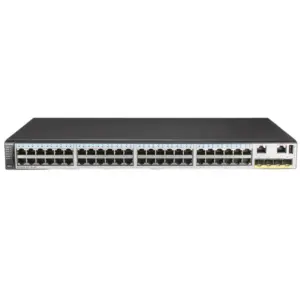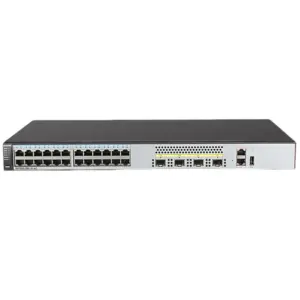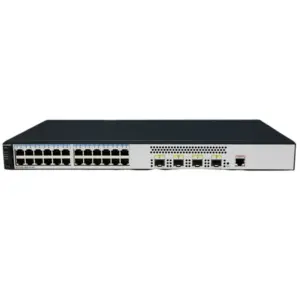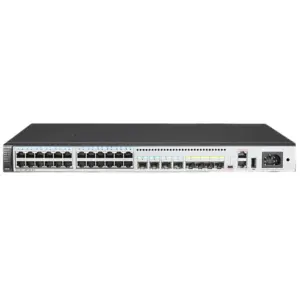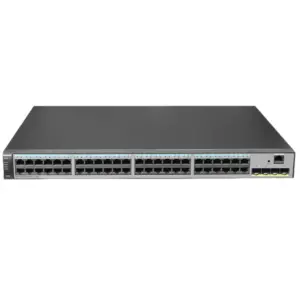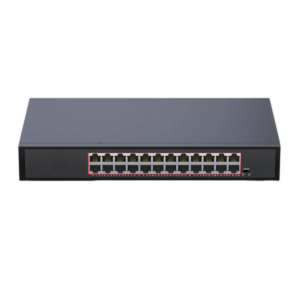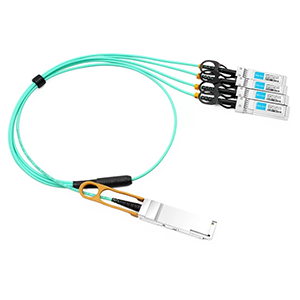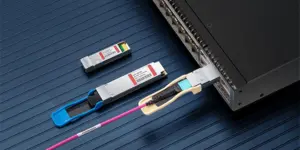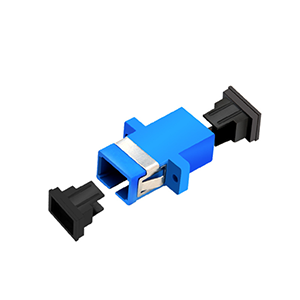As someone who is passionate about networking technology, I am fascinated by the capabilities and application areas of 10G switches. In this article, I will introduce you to the basic principles of 10G switches, application areas, and its importance as a means to meet the growing high-bandwidth demands in modern networks.
We will also discuss the features and benefits of 10G switches, including advantages in transfer rates and bandwidth, number and type of ports, as well as scalability and manageability. In addition, I will provide important information on the technical standards and specifications for 10G switches, as well as guidance on deployment and configuration.
10G switch introduction
Definition and rationale:
A 10G switch is a network device used to achieve high-speed data transmission and data exchange in a local area network (LAN). It supports the 10 Gigabit Ethernet (10GbE) standard, which can provide data transfer rates of 1 billion bits per second (or 10Gbps). Compared with traditional Gigabit Ethernet (1GbE), 10G switches provide higher bandwidth and faster data transfer speeds.
The basic working principle of 10G switch is as follows:
-
Data frame reception: When a data frame is sent from a device in the network to the switch, the switch will receive the data frame and process it according to the target MAC address.
-
Learning MAC addresses: The switch records the MAC address of each device connected to it and stores it in an address table. This way, the switch knows which device is on which port.
-
Data forwarding: When the switch receives the data frame, it checks the destination MAC address and looks up the address table to determine the location of the destination device. The switch then forwards the data frame to the port to which the target device is connected.
-
Broadcast and multicast processing: The switch can process broadcast (Broadcast) and multicast (Multicast) data frames. Broadcast data frames are forwarded by the switch to all connected devices, while multicast data frames are selectively forwarded based on the address of the destination device.
In short, as a solution to meet the growing high-bandwidth demands in modern networks, 10G switches can support big data transmission, virtualized environments, high-density users, and high-speed storage by providing higher data transmission rates and greater bandwidth capacity. application requirements.
Application areas of 10G switches
Data center network:
10G switches have a wide range of applications in data center networks. Data centers usually need to handle large amounts of data transmission and real-time data processing, and 10G switches provide high-speed data transmission capabilities and low-latency data exchange. It can connect servers, storage devices and other network devices, support fast data access and transmission, and meet the bandwidth, performance and reliability requirements of data center networks.
High performance computing:
In high-performance computing environments, large-scale data transmission and processing are required. 10G switches can provide high-bandwidth and low-latency network connections for connecting computing nodes, storage devices and switching nodes in high-performance computing clusters. It can support fast data transmission and parallel computing, meeting the needs of high-performance computing environments for large-scale data processing and high-speed data exchange.
Video surveillance system:
Video surveillance systems usually need to transmit and process high-definition video streams, and provide real-time monitoring and video storage functions. 10G switches can provide sufficient bandwidth to support the transmission of high-definition videos, ensuring the quality and real-time nature of video streams. It can connect surveillance cameras, surveillance servers and storage devices, and supports parallel transmission and real-time monitoring of multiple video streams.
In addition, 10G switches can also be used in the following areas:
- High-speed interconnection: used for high-speed interconnection between remote office locations and data centers, supporting large-capacity data transmission and remote access.
- Academic research: In academic research fields such as astronomy, bioinformatics and physical simulation, large-scale data processing and analysis are required. 10G switches can provide high-performance network connections to support large-scale data transmission and distributed computing.
Features and advantages of 10G switches
Transfer rate and bandwidth:
One of the main features of 10G switches is to provide high-speed transmission rates and large bandwidth capabilities. It supports data transfer rates of 10 Gigabit per second (Gbps), which is 10 times faster than traditional Gigabit Ethernet (1Gbps). This high-speed transmission rate can meet the needs of big data transmission, high-definition video streaming and real-time applications in modern networks, providing faster data exchange and transmission capabilities.
Number and type of ports:
The number and type of ports on a 10G switch can vary based on the specific device and manufacturer. Typically, 10G switches provide multiple 10Gbps ports to support high-speed data transmission. These ports can include fiber optic ports (such as SFP+ or XFP interfaces) and electrical ports (such as RJ45 interfaces). Fiber optic ports are suitable for long-distance transmission and high-speed connections, while electrical ports are suitable for short-distance transmission and connections to common devices.
Scalability and manageability:
10G switches have good scalability and manageability, making them suitable for network environments of different sizes and needs. It can support flexible network configuration and expansion to adapt to growing bandwidth needs. 10G switches typically have a stackable or modular design that allows the number of ports and bandwidth capacity to be expanded by adding additional switches or modules.
In addition, 10G switches usually have rich management functions, such as virtual LAN (VLAN) support, load balancing, flow control, and QoS (Quality of Service). These functions can help administrators flexibly configure and manage the network to ensure network performance, security, and reliability.
Technical standards and specifications for 10G switches
Switch architecture:
10G switches are usually built based on technical standards such as Ethernet and Fiber Channel. Ethernet is a standard network protocol widely used in local area networks (LANs) and data center networks. 10G switches follow the Ethernet standard and support the data transmission rate of 10 Gigabit Ethernet (10GbE). This high-speed Ethernet technology enables 10G switches to provide large bandwidth and high-speed transmission capabilities.
In addition, some 10G switches also support Fiber Channel technology (Fiber Channel) for connecting storage devices and networks. Fiber Channel is a high-speed serial communication protocol designed for storage area networks (SANs), which provides high-performance, low-latency, and reliable storage connections.
VLAN and QoS:
10G switches support key features such as virtual LANs (VLANs) and quality of service (QoS) to provide more flexible and manageable network configurations.
Virtual LAN (VLAN) is a logical division that can divide a physical network into multiple virtual logical networks. By using VLANs, administrators can group different devices and users into different virtual networks to isolate and manage network resources. 10G switches support the VLAN function, which can create and configure multiple VLANs as needed, and allow communication or isolation between different VLANs.
Quality of Service (QoS) is a network management mechanism used to optimize and guarantee the transmission quality of specific traffic. 10G switches provide QoS capabilities that allow administrators to set priorities and bandwidth limits for different types of network traffic. By configuring QoS parameters, you can ensure that the bandwidth and delay requirements of key applications are met, improving network performance and user experience.
In addition to VLAN and QoS, 10G switches may also support other technical standards and specifications, such as Spanning Tree Protocol (STP) for loop elimination, Link Aggregation (LAG) for port binding and redundancy, etc.
10G switch deployment and configuration
Network topology design:
Before deploying 10G switches, you first need to design the network topology. Network topology design involves the placement of core and edge switches, and how they are connected. The following are some common network topology design options:
-
Core-edge topology: In this design, one or more core switches are connected to multiple edge switches. Core switches handle high-bandwidth traffic and routing functions in the network, while edge switches connect to end devices such as servers, workstations, and network storage. This topology design can provide high-bandwidth and low-latency data transmission and support network reliability and scalability.
-
Dual-core topology: In this design, there are two core switches redundantly connected to each other, with each core switch connected to multiple edge switches. This design provides higher reliability and redundancy to ensure network connectivity and failure recovery.
-
Stacking topology: Some 10G switches support stacking functionality, allowing multiple switches to be stacked together to form a logical unit. In this design, the stacked switches can be considered as a whole, providing higher bandwidth and port count. This design is suitable for network environments that require a large number of ports and high bandwidth.
Network Configuration:
Once the network topology design is completed, the network configuration of the 10G switch can be carried out. Here are some common network configuration methods:
-
Port configuration: For each 10G switch port, it needs to be configured to meet specific needs. This includes configuring parameters such as port speed (e.g. 10Gbps), duplex mode (full or half duplex), and flow control. In addition, functions such as virtual LAN (VLAN) and link aggregation (Link Aggregation) can also be configured to achieve more flexible network configuration and management.
-
VLAN configuration: VLAN can realize the isolation and management of different devices and users. By configuring VLANs, you can group different ports or devices into different virtual networks. Administrators can set parameters such as VLAN ID, VLAN name, and VLAN membership to achieve the desired network division and isolation.
-
Link aggregation configuration: Link aggregation allows multiple physical links to be bound into one logical link to provide higher bandwidth and redundancy. By configuring link aggregation, links between multiple 10G switches can be bound into one logical link, increasing bandwidth and improving reliability.
In addition, quality of service (QoS) parameters, security settings, remote management and monitoring functions can be configured to meet specific network needs.
Compatibility and interface types of 10G switches
Compatibility points:
Compatibility points for 10G switches include compatibility with other devices and network interfaces. Here are some compatibility aspects to consider:
-
Equipment compatibility: 10G switches should be compatible with other equipment in the network, such as servers, workstations, storage devices, etc. This includes ensuring that the interface type and configuration of the 10G switch matches other equipment to enable normal data transmission and communication.
-
Protocol compatibility: 10G switches should support compatibility with protocols used by other devices to ensure correct data exchange and communication. For example, 10G switches need to support the Ethernet protocol to communicate with common Ethernet devices.
-
Network topology compatibility: The network topology design of 10G switches should be compatible with other devices and topologies in the network. If there are other types of switches or routers in the network, the 10G switch should be able to work with them and implement the required data transmission and routing functions.
Interface Type:
10G switches usually provide multiple interface types to adapt to different network needs and device connections. The following are common interface types of 10G switches:
-
SFP+ (Small Form-Factor Pluggable Plus): SFP+ is a small pluggable optical module used for optical fiber connections. It supports 10G Ethernet transmission rates and can be used with single-mode fiber or multi-mode fiber. SFP+ interfaces are commonly used to connect fiber switches, servers, storage devices, etc.
-
RJ45: The RJ45 interface is a common Ethernet interface that is often used to connect devices through copper cables. For 10G Ethernet, the RJ45 interface usually uses Cat6a or Cat7 copper cable to support high-speed data transmission.
-
QSFP+ (Quad Small Form-Factor Pluggable Plus): QSFP+ is a four-channel small pluggable optical module used for high-density data transmission. It supports transmission rates of four 10G channels or one 40G channel. QSFP+ interfaces are commonly used to connect devices such as high-speed servers, data center networks, and network storage.
In addition to the above interface types, there are other interface types available for 10G switches, such as XFP (10 Gigabit Small Form Factor Pluggable), CX4 (InfiniBand), etc. These interface types vary according to specific equipment and manufacturers.
When selecting a 10G switch, you need to consider the required interface type and compatibility points to ensure matching with other devices and network interfaces to achieve smooth data transmission and communication.
Summarize:
As a solution to meet the growing high-bandwidth demands in modern networks, 10G switches offer excellent performance and flexibility. By understanding its basic principles, application fields and technical standards, we can better utilize 10G switches to achieve high-speed data transmission and data processing in areas such as data center networks, high-performance computing and video surveillance systems.
Whether in terms of transmission rate and bandwidth, port number and type, scalability and manageability, 10G switches demonstrate excellent performance and flexibility. Hopefully this article has provided you with valuable information that will make you more confident and successful in the world of networking technology.
- Are there 10gb network switches?
- Is a 10gb switch worth it?
- What is the cost of 10G switch?
- What is the difference between 1gb switch and 10gb switch?
- Do I need a 10gb switch at home?
- How fast is 10 gigabit switch?
- Do I need a 1000 Mbps switch?
- Do I need a gigabit switch or 10 100mbps switch?
- What is the latency of a 10gb switch?


